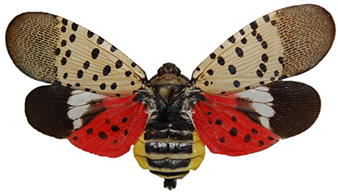JEFFERSON CITY – Spotted lanternflies are planthoppers in the order Hemiptera, or true bugs, and are more closely related to cicadas, brown marmorated stink bugs, aphids, and leafhoppers.

All insects in this order have piercing-sucking mouthparts that allow them to drill into the phloem of a plant to feed directly on the sugary sap.
This bad bug has the potential to damage our forests and food supply by feeding on trees and crop plants. The SLF is also a threat to recreation and tourism in our state.
The SLF finds its way to new areas primarily by hitchhiking with humans. They lay their egg masses on any hard, smooth surface, including firewood, landscape materials, outdoor furniture, vehicles and more.
Spotted lanternflies go through five stages of growth after hatching from eggs. The first four stages are called nymphs. The tiny nymphs are initially black with white spots, often mistaken for ticks, but eventually develop red areas on their bodies. Adults are about an inch long, are gray and black, and have hind wings with bright red patches.
Adult spotted lanternflies are present from July through December. Egg masses of 30-50 eggs overwinter and hatch in the spring.
Spotted lanternflies begin to hatch in May. The first instar nymphs are active from May until July.
Learn more on how to check for SLF egg masses this spring and adult SLF this summer at agriculture.mo.gov
